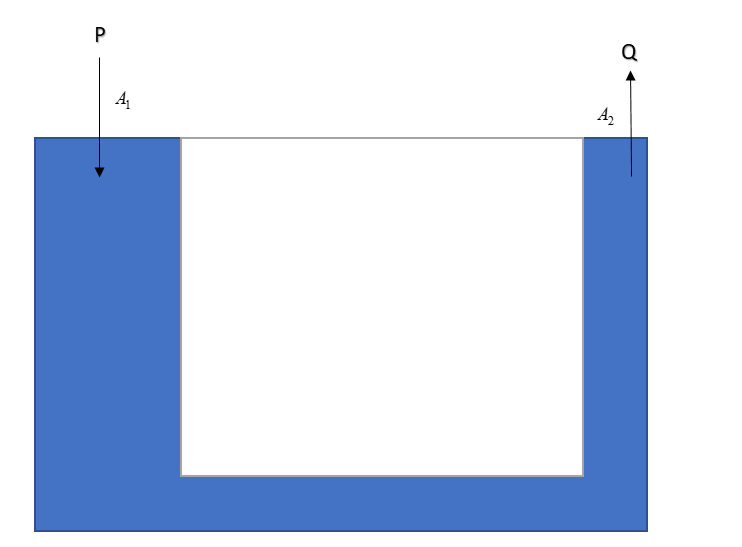
In a brahma press a force of 10N is applied on a piston of cross section
Answer
492k+ views
Hint: In brahma press, there are two sides of different cross-sectional areas. On one side we have a larger area and on the other side, we have a smaller area. This system works on the basis of Pascal’s law. Pascal’s law states that pressure is transmitted equally to every direction in a fluid at rest, irrespective of the distance between two parts of the container.
Formula used:
Complete answer:

As shown in the above figure, we can see two limbs having area
Hence,
Given,
Hence using
Hence we get an upward thrust of 20N at the bigger end.
Additional Information:
This is the advantage of brahma press. We apply a smaller load, and get a hugely increased load at the bigger end. This could be used to lift heavy objects like trucks and cars. This is based on the fundamental principle of Pascal’s law.
Note:
Pressure is a scalar quantity. Hence its nothing to do with its direction. It gets transmitted in every direction equally when the fluid is at rest. The phenomenon of getting an additional or increased force on the other end of the instrument is also called mechanical advantage. But this phenomenon has a limitation either. Practically there is a limit after which the fluid gets compressed as no fluid is ideally incompressible.
Formula used:
Complete answer:

As shown in the above figure, we can see two limbs having area
Hence,
Given,
Hence using
Hence we get an upward thrust of 20N at the bigger end.
Additional Information:
This is the advantage of brahma press. We apply a smaller load, and get a hugely increased load at the bigger end. This could be used to lift heavy objects like trucks and cars. This is based on the fundamental principle of Pascal’s law.
Note:
Pressure is a scalar quantity. Hence its nothing to do with its direction. It gets transmitted in every direction equally when the fluid is at rest. The phenomenon of getting an additional or increased force on the other end of the instrument is also called mechanical advantage. But this phenomenon has a limitation either. Practically there is a limit after which the fluid gets compressed as no fluid is ideally incompressible.
Recently Updated Pages
Master Class 9 General Knowledge: Engaging Questions & Answers for Success

Master Class 9 English: Engaging Questions & Answers for Success

Master Class 9 Science: Engaging Questions & Answers for Success

Master Class 9 Social Science: Engaging Questions & Answers for Success

Master Class 9 Maths: Engaging Questions & Answers for Success

Class 9 Question and Answer - Your Ultimate Solutions Guide

Trending doubts
State and prove Bernoullis theorem class 11 physics CBSE

What are Quantum numbers Explain the quantum number class 11 chemistry CBSE

Who built the Grand Trunk Road AChandragupta Maurya class 11 social science CBSE

1 ton equals to A 100 kg B 1000 kg C 10 kg D 10000 class 11 physics CBSE

State the laws of reflection of light

One Metric ton is equal to kg A 10000 B 1000 C 100 class 11 physics CBSE




